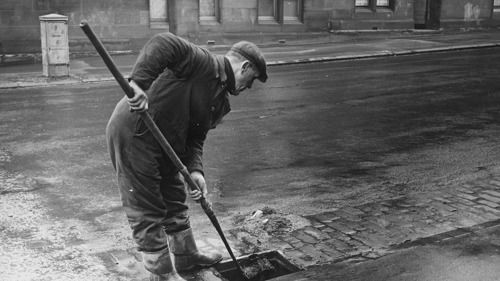Street Cleansing - Times Past

In partnership with the Glasgow Times, our archivists are exploring Glasgow's fascinating history. This week, Michael Gallagher writes about the Corporation's Cleansing Department.
The cleanliness of Glasgow’s streets has been a hot topic for centuries.
The city’s early residents, who lived around the Trongate and High Street, would often simply throw their refuse into “middings” at the front of their homes which naturally created problems. In 1589 the magistrates issued an order “that na middings be laid upoun the Hiegait”, but this appears to have made little difference and the custom continued.
A statute of 1608 introduced a fine of five pounds for fouling the streets and recognised that it was not only “uncumlie and incivil” but also “verie dangerus in tyme of plaig and pestilence”.
Sanitary reform progressed slowly, however. By the end of the 17th century it was ordained “that the streets be clated [scraped] and made clean once everie week”, but as late as 1777 only two people were employed to carry out this unenviable job. The unfortunate duo were joined by a third colleague by the end of that year but it was not until 1800 that the cleaning of the streets moved from being a personal duty to a public one, with the passing of the Police Act.
Cleansing was overseen by the Chief Constable and the work was initially carried out by the night-watchmen, or police, who were instructed to spend two hours each week cleaning the streets. By 1815 a cleaning staff of 16 men were in place, with most paid 11 shillings weekly.
Over the next fifty years the police board gradually took control of more tasks so that by 1866 it undertook the cleansing of the entire city, the removal and disposal of refuge and the sweeping and watering of the streets. In 1868 the Cleansing Department was established to carry out these duties and an inspector was appointed.
The growth of the city created many challenges for the new department. In 1868 it employed 723 men and dealt with 140,000 tons of refuse, but by the eve of the First World War Glasgow’s population had more than doubled to over one million people and the Cleansing Department’s 1667 employees had to dispose of 387,000 tons of rubbish.
Technological developments helped. Street sweeping was at first carried out by hand, but the introduction of horse-drawn brushes then motor sweeping machines enabled the city to deal with the volume.
Horses were integral to the cleanliness of Glasgow. The Cleansing Department operated stables in Bell Street and its farms supplied hay, straw and grain to depots across the city.
When the city’s equine employees were eventually replaced by machines, one occupation rendered obsolete was the “pan boy” – a youth who was employed to collect manure from under the feet of horses using a small hand brush and shovel. As one Glasgow Corporation report explained, rather dryly, this dangerous practice “perhaps gives some indication of the extent to which the Department was prepared to go to keep the streets tidy.” Indeed!
